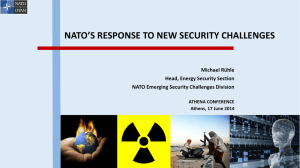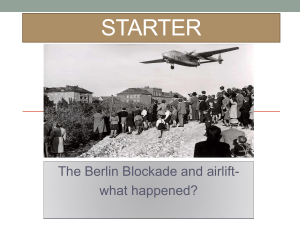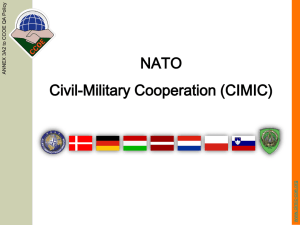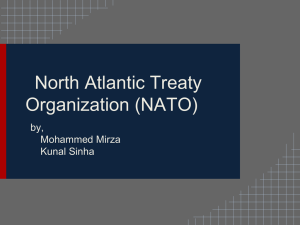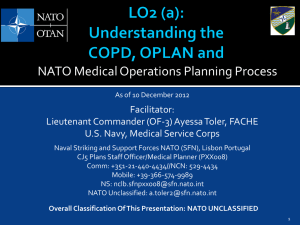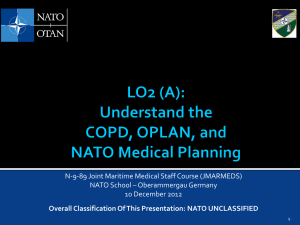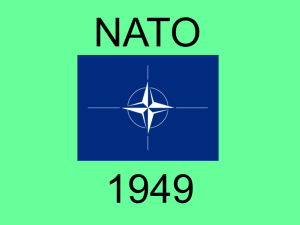S&T - truecanadians.org
advertisement
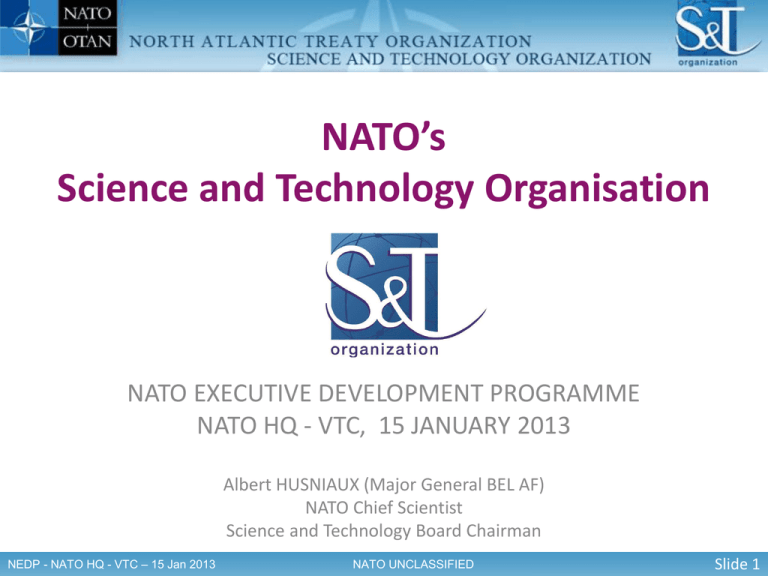
NATO’s Science and Technology Organisation NATO EXECUTIVE DEVELOPMENT PROGRAMME NATO HQ - VTC, 15 JANUARY 2013 Albert HUSNIAUX (Major General BEL AF) NATO Chief Scientist Science and Technology Board Chairman NEDP - NATO HQ - VTC – 15 Jan 2013 NATO UNCLASSIFIED Slide 1 Outline • The new NATO S&T Organisation (STO) • Programme of Work generation – The Centre for Maritime Research and Experimentation – STO’s Collaborative S&T network, supported by its Support Office • Challenges • Contact information • Conclusions NEDP - NATO HQ - VTC – 15 Jan 2013 NATO UNCLASSIFIED Slide 2 The new NATO S&T Organisation (STO) NEDP - NATO HQ - VTC – 15 Jan 2013 NATO UNCLASSIFIED Slide 3 NATO’s Science & Technology Organization (STO) • Established on 1 July 2012 as the outcome of NATO S&T Reform • Successor to the former NATO Undersea Research Centre (NURC) and the NATO Research & Technology Organisation (RTO), combining their expertise and legacy of over 60 years • Establishing a NATO Chief Scientist position NEDP - NATO HQ - VTC – 15 Jan 2013 NATO UNCLASSIFIED Slide 4 Drivers of the NATO S&T Reform • The scarcity of resources – NATO’s reforms • The difference S&T makes in today’s strategic context – Global, complex, interdependent, speed • The need to extract more value out of NATO S&T – A NATO wide approach: unified governance of NATO S&T • NATO S&T Strategy, priorities, coordination, synergy – More visibility, more accessibility, more imbrication in the processes and the decision making • Permanent S&T presence and leadership in the HQ: NATO Chief Scientist and Office • “Demand-Supply’ dialogue: managing expectations NEDP - NATO HQ - VTC – 15 Jan 2013 NATO UNCLASSIFIED Slide 5 Mission (Charter, 19 June 2012) • To help position the Nations’ and NATO’s S&T investments as a strategic enabler of the knowledge and technology advantage for the defence and security posture of NATO Nations and partner Nations, by: – Conducting and promoting S&T activities that augment and leverage the (S&T) capabilities and programmes of the Alliance, of the NATO Nations and the partner Nations [...] – Contributing to NATO’s ability to enable and influence security- and defence-related capability development and threat mitigation [...] – Supporting decision-making in the NATO Nations and NATO NEDP - NATO HQ - VTC – 15 Jan 2013 NATO UNCLASSIFIED Slide 6 NATO S&T Unified Governance: NATO S&T Strategy Strategic and Operational Decisions Knowledge, Analysis, and Advice Networks of National and NATO S&T Subject Matter Experts Capability Development Military Operations NEDP - NATO HQ - VTC – 15 Jan 2013 Consultation and Partnerships Security Dialogue and Cooperation NATO UNCLASSIFIED Slide 7 The Science and Technology Organisation • S&T Programme delivery – Nations’ and NATO bodies’ network of Scientists and Engineers, delivering through a collaborative business model • Scientific and technical committees, composed of subject matter experts, supported by a Collaborative S&T Support Office (CSO) – NATO’s Research and Experimentation Centre • Centre for Maritime Research and Experimentation (CMRE) • NATO S&T and STO governance and leadership – Governance is vested in the Science and Technology Board – Leadership is exercised by the Chief Scientist, Chair of the S&T Board and Scientific Advisor to NATO leadership NEDP - NATO HQ - VTC – 15 Jan 2013 NATO UNCLASSIFIED Slide 8 Programme of Work Delivery A Lab The in-house delivery business model: a dedicated STO executive body, having its own personnel, specific capabilities and infrastructure, customerfunded A network for Nations and of (by) Nations The collaborative business model: a forum where Nations elect to share national resources to conduct cooperative research (supported by a NATO body) NEDP - NATO HQ - VTC – 15 Jan 2013 NATO UNCLASSIFIED Slide 9 Value Added • A Nation: – “The value of the existence of the STO is within the Nations” • Through the network, making the Nation and thus NATO stronger • Consider the STO as a lever, a multiplier, ... – The STO is not “the Research Institute of NATO” • ... With the exception of the CMRE, which is a NATO Centre for Research and Experimentation NEDP - NATO HQ - VTC – 15 Jan 2013 NATO UNCLASSIFIED Slide 10 NORTH ATLANTIC COUNCIL MC Science and Technology Board 1 Board OCS CNAD NATO HQ Max. 10 Max. 0.7 M€ Collaborative S&T Business Model 2 Business Models Technical Committees (Panels/Group) CSO Neuilly 51 5.5 M€ In House Delivery Business Model 3 Exec Bodies CMRE La Spezia 150 26.6 M€ Science and Technology Organisation NEDP - NATO HQ - VTC – 15 Jan 2013 NATO UNCLASSIFIED Slide 11 STO deliverables Collaborative S&T Network Network, delivering validated knowledge and information for Defence and Security Reports & Standards Technology Demonstrations Educational Opportunities Toolbox: • Task Groups • Workshops • Symposia • Lecture Series • Specialists’ Meetings • Technical Courses • Exploratory Teams • Specialists’ Teams NEDP - NATO HQ - VTC – 15 Jan 2013 Centre for Maritime Research and Experimentation Innovative and field-tested S&T solutions to address the defence and security needs of the Alliance Core Research and Experimentation Capability Development Talent Development Portfolio: • Autonomous • Environmental Security Knowledge and Networks Operational • Active Sonar Risk Effectiveness Mitigation • Ocean • Exploring Future Engineering Technologies NATO UNCLASSIFIED Slide 12 Expertise • Centre for Maritime Research and Experimentation – Maritime, and particularly the undersea; may extrapolate into other domains to meet customers’ demands • STO Technical Committees (Panels-Group) – – – – – – – Applied Vehicle Technology Human Factors and Medicine Information Systems Technology Modelling and Simulation Systems Concepts and Integration System Analysis and Studies Sensors and Electronics Technology NEDP - NATO HQ - VTC – 15 Jan 2013 NATO UNCLASSIFIED Slide 13 The STO in NATO North Atlantic Council C3B C&I-ASB C3B CaPs NATO C&I Agency Political & Partnership Committee Non-NATO “S&T partners” STO One Board NEDP - NATO HQ - VTC – 15 Jan 2013 LC Science for Peace & Security Programme Allied Command Transformation Conference of National Armament Directors Military Committee COMEDS NATO Army Armaments Group S&T Board NATO Naval Armaments Group STO OCS NATO Air Force Armaments Group Collaborative S&T CSO NATO Industrial Advisory Group In-house S&T CMRE Two Business Models NATO UNCLASSIFIED Three Executive Bodies Slide 14 Technology Readiness Levels’ Spectrum Technology Readiness Level (TRL) 1 2 3 4 Concept Refinement 5 6 7 Technology System Development Prototyping & Development Demonstration Fundamental & Applied Research 8 Production & Development 9 Operations & Support Main Armament Groups Science for Peace & Security STO/CSO ACT STO/CMRE NEDP - NATO HQ - VTC – 15 Jan 2013 NCIA NATO UNCLASSIFIED Slide 15 Programme of Work • Very broad scope – From “Traditional” technology to “Human Factors” – From “Conceptual/systems” thinking to “support to delivering hardware” – From the (very) long term to the shorter term – From the “physical space” (air, land, sea ...) to the virtual space (cyberspace) – ... NEDP - NATO HQ - VTC – 15 Jan 2013 NATO UNCLASSIFIED Slide 16 Welcoming Partners • Revised Cooperation Policy in accordance with NATO Partnership Policy • Collaborative S&T: Flexible Formats + targeted approach – Partner hosting meetings and holding leadership in several activities (3 currently) – As of March 2012, among over 165 on-going CSO activities: • 75% open to Partnership for Peace (PfP) 30% open to Mediterranean Dialogue (MD) – Cooperation Programme with Partners: a Partnership Work Programme is distributed to the PfP missions to NATO in the fall – This allows Partners to participate in: • • • Joint sessions of the RTB and Panels with Partners RTO Technical Teams, Symposia, etc. • Partners are potential CMRE customers, for S&T activities in line with NATO policies NEDP - NATO HQ - VTC – 15 Jan 2013 NATO UNCLASSIFIED Slide 17 Engaging with Industry: NATO’s initiatives • Engagement with Industry is high on NATO’s agenda: – ACT’s Industry Day (started in 2004) – NIAG Initiatives: TADIC (Trans-Atlantic Defence Technological and Industrial Cooperation ) Conferences (last one in Oct 2011) – RUSI Conference (March 2012) – Specifically on S&T matters: STB Roundtable on “early engagement with Industry” (March 2012) – 2012: first NATO Industry Day (ACT & Defence Investment Division) – Smart Defence and Connected Forces Initiative NEDP - NATO HQ - VTC – 15 Jan 2013 NATO UNCLASSIFIED Slide 18 NATO S&T Unified Governance: NATO S&T priorities • “Push-Pull” – STB leadership • Drivers/lists – Military requirements (important role for Allied Command Transformation) – Hard Problems – Emerging/emerged Disruptive Technologies • “Game Changers” • To be updated – S&T Strategy and S&T Strategy implementation first NEDP - NATO HQ - VTC – 15 Jan 2013 NATO UNCLASSIFIED Slide 19 The Centre for Maritime Research and Experimentation NEDP - NATO HQ - VTC – 15 Jan 2013 NATO UNCLASSIFIED Slide 20 Centre for Maritime Research and Experimentation •… organizes and executes a customer-funded programme of scientific research and technology development centred on the maritime domain, and focused on solutions for the defence and security needs of the Alliance •It will sustain its core capabilities in the maritime, and particularly the undersea, domain and, conformant with STB policy guidance, may extrapolate into other domains to meet customers’ demands NEDP - NATO HQ - VTC – 15 Jan 2013 NATO UNCLASSIFIED Slide 21 CMRE • A Centre where scientists and engineers gather to collaborate on maritime research priorities of the NATO Nations • A Centre where the nations pool their equity in specialized, sea-going platforms, and share the costs, efforts, data and results of a maritime research programme • A place and a programme to develop, demonstrate, and de-risk emerging maritime technology SMART DEFENCE NEDP - NATO HQ - VTC – 15 Jan 2013 NATO UNCLASSIFIED Slide 22 Collaboration At Sea R/V ALLIANCE NEDP - NATO HQ - VTC – 15 Jan 2013 R/V LEONARDO NATO UNCLASSIFIED Slide 23 Portfolio • The CMRE programme of work for NATO Allied Command Transformation, is organized into a portfolio of four program areas: – Cooperative Anti-Submarine Warfare – Autonomous Naval Mine Countermeasures – Environmental Knowledge and Operational Effectiveness – Maritime Security and awareness , Harbor and port protection, and modeling and simulation NEDP - NATO HQ - VTC – 15 Jan 2013 NATO UNCLASSIFIED Slide 24 The CMRE Team • Highly-skilled interdisciplinary professionals – recruited from NATO nations. – physicists, engineers, mathematicians • Specialists in sea-going experimentation, – Over 50 years experience preparing instrumentation and performing controlled measurements at sea • Unique expertise in research, development, testing and evaluation of ocean and maritime concepts and equipment. • Visiting Scientists and Joint Research Programs NEDP - NATO HQ - VTC – 15 Jan 2013 NATO UNCLASSIFIED Slide 25 CMRE Core Competencies • Oceanographic instrumentation, platforms, and systems • Underwater acoustics • Sensors and signal processing • Hydrographic systems • Ocean prediction • Ocean physics • Portable sensors in the maritime domain • Autonomy in the maritime domain • Sonars, transducers, and arrays • Computation and data management • Ocean engineering • Underwater communications engineering • Seagoing capability • Exploitation of remote sensing at sea • Modeling and simulation in the maritime domain NEDP - NATO HQ - VTC – 15 Jan 2013 • Operations research • AUVs, USVs and gliders • Calibration NATO UNCLASSIFIED Slide 26 NATO’s Collaborative S&T: A Network for Nations and of (by) Nations supported by the CSO NEDP - NATO HQ - VTC – 15 Jan 2013 NATO UNCLASSIFIED Slide 27 Collaborative NATO S&T Business Model JWC, JFTC ACT ACT CE AC0 Nation NATO C&I Agency Rep. NETWORK HUB = STO-CSO Nation Member (Req) Nation SMART DEFENCE NEDP - NATO HQ - VTC – 15 Jan 2013 Nation Member (IND) (AC) C&IO Nation Member (Ops) Nation Member (S&T) MAGs Member NATO UNCLASSIFIED Nation Nation MAGs-NIAG Slide 28 PoW: Stability & Control prediction methods • AVT-161: Assessment of Reliable Stability & Control Prediction Methods for NATO Air Vehicles and Sea Vehicles (2009-2012) • AVT-216: Evaluation of Prediction Methods for Ship Maneuvering and Control (follow-on) • Objectives: Assess the state-of-the-art in computational fluid dynamics methods • RESOURCES funded by 15 Nations • Labour Cost for 25 active participants (over 3 years) • Transportation & Shipment Cost • Production Cost of Wind Tunnel Model • Wind Tunnel Test Facilities (2 x Europe, 1 x USA) • RESOURCES (direct) funded by NATO • Editorial & Publication Services, Panel Support • Research Results are available to all NATO Nations! NEDP - NATO HQ - VTC – 15 Jan 2013 NATO UNCLASSIFIED Slide 29 Deliverables: Collaborative S&T Toolbox: • Network delivering validated knowledge and information for Defence and Security SY: Symposia (>100 people, 3-4 days) • SM: Specialists’ Meetings (<100 people, 2-3 days ) • WS: Workshops (selected participation, 2-3 days) Reports & Standards Technology Demonstrations Educational Opportunities • TG: Task Groups (study group, 3 years max.) • LS: Lecture Series (junior and mid-level scientists) A Knowledge & Information Base for NATO and the Nations NEDP - NATO HQ - VTC – 15 Jan 2013 NATO UNCLASSIFIED • TC: Technical Courses • ST: Specialists’ Teams (quick reaction) • ET: Exploratory Teams Slide 30 Participation Trends Total # Activities per Nation NEDP - NATO HQ - VTC – 15 Jan 2013 NATO UNCLASSIFIED Slide 31 Challenges NEDP - NATO HQ - VTC – 15 Jan 2013 NATO UNCLASSIFIED Slide 32 Transition Plan and Phases • Three Phases – Consolidation Phase (until 31 Dec 2012) – Rationalisation Phase (1 Jan 2013 - Jul 2014 - TBC) – Optimization Phase (Jul 2014 - Jul 2015) • Phase 1 – Consolidation Phase – – – – – STO stand-up by 1 July 2012 Achieve a “steady state” by the end of 2012 Deliver a CMRE Business Plan by the end of 2012 Deliver a NATO S&T Strategy by the end of 2012 Deliver an Operational Research and Analysis Study by the end of 2012 NEDP - NATO HQ - VTC – 15 Jan 2013 NATO UNCLASSIFIED Slide 33 Transition Plan and Phases • Phase 2: rationalization phase (1 Jan 2013 – July 2014, TBC) – Transition the CMRE to its new business model; – Implement the decisions pertaining to the ORA study – Implement the NATO S&T Strategy – Conduct the “further consolidation” study asked for by the Nations • Do we need to push the S&T Reform further? • Timelines for this phase need to be confirmed NEDP - NATO HQ - VTC – 15 Jan 2013 NATO UNCLASSIFIED Slide 34 Transition Plan and Phases • Phase 3 – Optimization phase (Jul 14, Jul 15, TBC) – Optimize the measures of the rationalization phase. – Implement the decisions pertaining to the “further consolidation” study. – Lessons learned from the first two years, the conclusions of the “further consolidation” study and the overall requirements from ongoing NATO reforms will drive this phase • Timelines for this phase need to be confirmed NEDP - NATO HQ - VTC – 15 Jan 2013 NATO UNCLASSIFIED Slide 35 Challenges • S&T Reform challenges - STB – Implementation of the governance of the STO – Implementation of unified governance of NATO S&T (inter alia delivering the NATO S&T strategy and the specific studies) – Definition of the mandate/accountabilities/empowerment of the Chief Scientist – Implement transition while preserving S&T delivery to the Nations and to NATO • S&T Reform challenges - Chief Scientist – Definition and implementation of the ISPE of his office (Budget, funding and staffing) – Definition and implementation of the Senior Scientific Advisor role NEDP - NATO HQ - VTC – 15 Jan 2013 NATO UNCLASSIFIED Slide 36 Challenges • S&T Reform challenges - CMRE – Shift in command relationship from ACT to the governance context of the STO – Shift from the Paris Protocol to the Ottawa Agreement – Shift from common funding to customer funding – Definition and implementation of the ISPE and the Personnel Establishment – Evolution of the Business Model (and Customer Portfolio) – New Host Nation Agreements and Memoranda of Agreement – Ownership, funding and flagging of the Research Vessels • S&T Reform challenges - CSO – Definition and implementation of the ISPE – Collaborative Programme of Work (PoW) connection to other NATO S&T PoW (e. g. SPSP, CMRE)/stakeholders’ objectives NEDP - NATO HQ - VTC – 15 Jan 2013 NATO UNCLASSIFIED Slide 37 NATO Chief Scientist’s Mandate (draft) • Objectives (expectations): – Achieve a successful transition – Position the Chief Scientist to be influential at senior levels – Identify a realistic level of ambition for NATO S&T – Increase the effectiveness and the efficiency of NATO S&T and implement continuous improvement NEDP - NATO HQ - VTC – 15 Jan 2013 NATO UNCLASSIFIED Slide 38 Deliverables: 2012-2013 picture 1 Jan 12 1 Jul 12 1 Jan 13 1 Jul 13 1 Jan 14 1 Jul 14 STO Charter NATO S&T Strategy CMRE 2013 Business Plan NATO S&T Strategy - Implementation ? CMRE 2014 Business Plan Maritime S&T Business Plan ORA Study ORA Study - Implementation Research Vessels Study Research Vessels - Impl ? ? Governance Implementation Programmes of Work NEDP - NATO HQ - VTC – 15 Jan 2013 NATO UNCLASSIFIED Slide 39 Stay in touch ... NEDP - NATO HQ - VTC – 15 Jan 2013 NATO UNCLASSIFIED Slide 40 www.sto.nato.int www.cso.nato.int General info News www.cmre.nato.int Social media General info Events Scientific Reports NEDP - NATO HQ - VTC – 15 Jan 2013 NATO UNCLASSIFIED Slide 41 Contact information • A full-time presence of the Chief Scientist and his Office at NATO HQ [PoC @ OCS: dotoli.pierpaolo@hq.nato.int] • The NATO Collaborative S&T Programme: building on/accessing Nations’ S&T [PoC @ CSO: philippe.soete@cso.nato.int] • CMRE’s capabilities can be used by single NATO nations as customers [PoC @ CMRE: miller@cmre.nato.int ] NEDP - NATO HQ - VTC – 15 Jan 2013 NATO UNCLASSIFIED Slide 42 Conclusions NEDP - NATO HQ - VTC – 15 Jan 2013 NATO UNCLASSIFIED Slide 43 Conclusions • The World is complex and increasingly interdependent, creating new challenges for Nations and NATO • NATO S&T makes the difference, by commonly addressing and anticipating security and defence needs of the Alliance and its member nations • The STO (either the Collaborative program or the CMRE) provides an attractive framework: all stakeholders can extract/leverage value out of NATO S&T, using interaction mechanisms having proved their effectiveness • The NATO S&T Reform is an ambitious reform, with many facets, involving Nations and involving the NATO HQ • Expectations are high and achieving success will continue to ask for hard work, generating and demonstrating the added value of NATO S&T, both in the Nations and in the NATO HQ (NATO processes and NATO decision making) NEDP - NATO HQ - VTC – 15 Jan 2013 NATO UNCLASSIFIED Slide 44 Thank you for your attention “ Scientific results cannot be used efficiently by soldiers who have no understanding of them, and scientists cannot produce results useful for warfare without an understanding of the operations.” Theodore von Kármán (1881-1963) NEDP - NATO HQ - VTC – 15 Jan 2013 NATO UNCLASSIFIED Slide 45 Your briefer • • • • • • • Albert Husniaux (Major General BEL AF) NATO Chief Scientist Chairman of the S&T Board NATO HQ, Brussels Tel PA: + 32 2 707 1904 Direct: + 32 2 707 1919 Email: husniaux.albert@hq.nato.int NEDP - NATO HQ - VTC – 15 Jan 2013 NATO UNCLASSIFIED Slide 46


